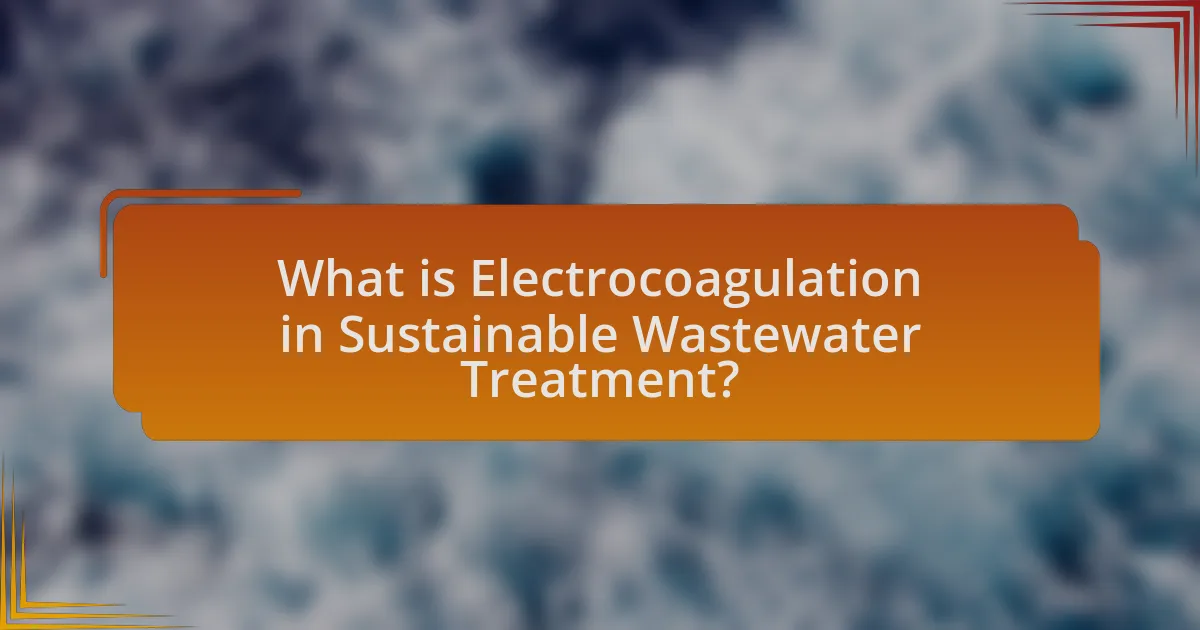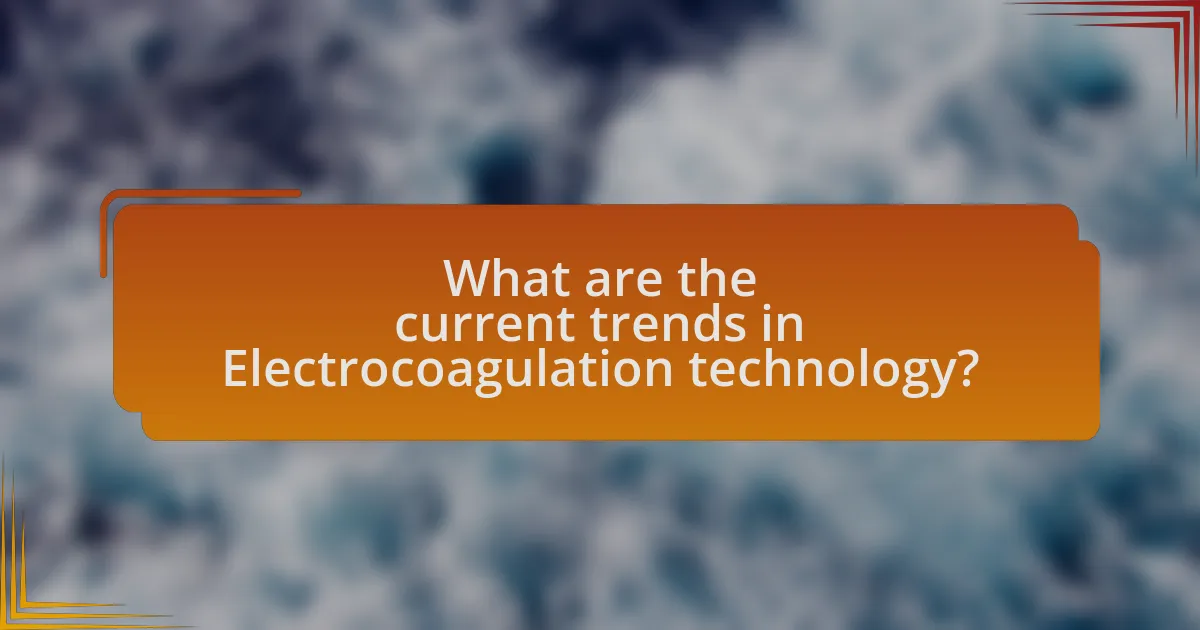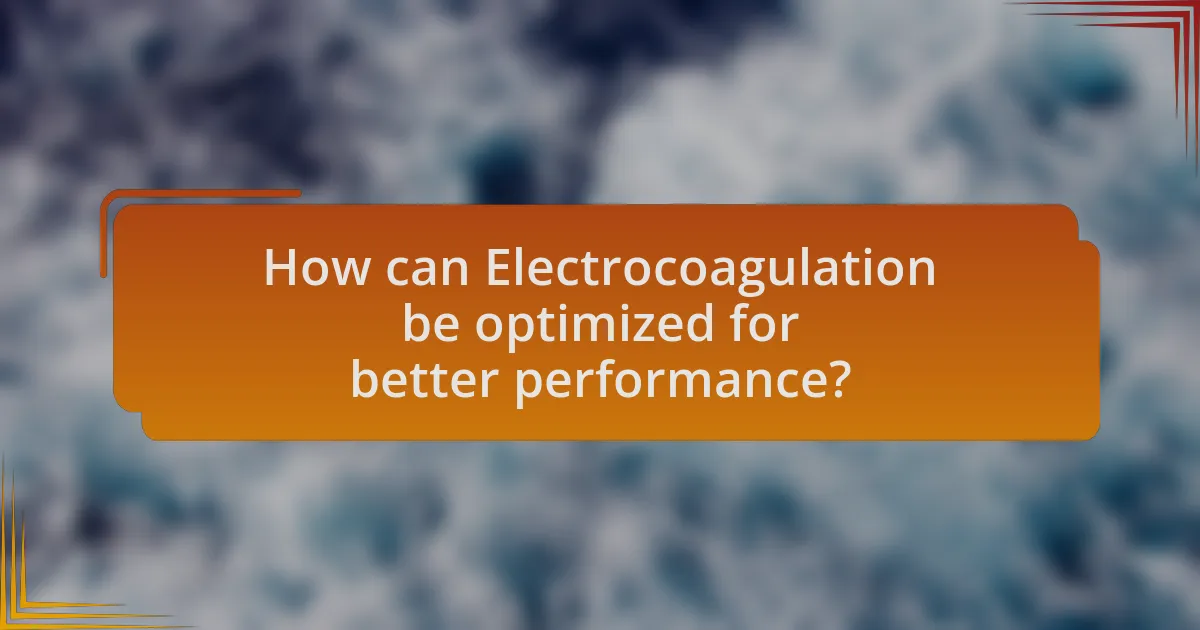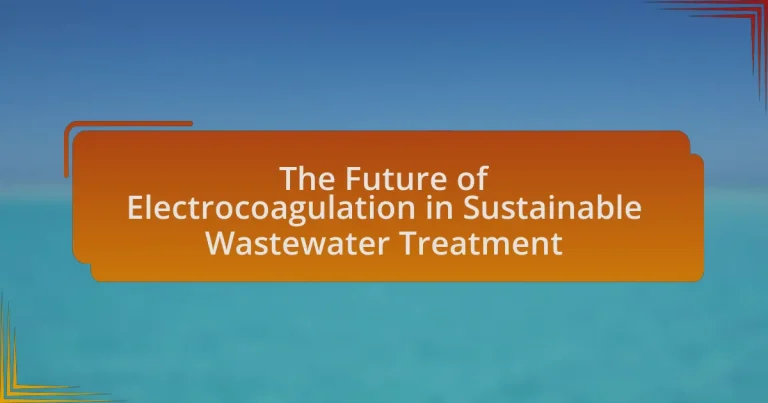Electrocoagulation is an innovative wastewater treatment process that employs electrical currents to effectively remove contaminants from water, including heavy metals, oils, and organic compounds. This article explores the mechanisms of electrocoagulation, its advantages over traditional methods, and its significant environmental benefits, such as reduced chemical usage and sludge production. Additionally, it examines current trends, challenges, and future developments in electrocoagulation technology, highlighting its potential applications beyond wastewater treatment and strategies for optimizing its performance in sustainable water management.
What is Electrocoagulation in Sustainable Wastewater Treatment?

Electrocoagulation is a wastewater treatment process that utilizes electrical currents to remove contaminants from water. This method promotes the aggregation of suspended particles and dissolved pollutants, facilitating their separation from the water. Studies have shown that electrocoagulation effectively reduces heavy metals, oils, and organic compounds, making it a viable option for sustainable wastewater management. The process is energy-efficient and generates minimal chemical waste, aligning with environmental sustainability goals.
How does Electrocoagulation function in wastewater treatment processes?
Electrocoagulation functions in wastewater treatment processes by using electrical currents to destabilize and aggregate contaminants, allowing them to be removed from the water. In this process, electrodes are submerged in the wastewater, and when an electric current is applied, it causes the release of coagulants such as aluminum or iron ions from the electrodes. These ions interact with suspended particles, emulsified oils, and other pollutants, forming larger aggregates or flocs that can be easily separated from the water through sedimentation or flotation. Studies have shown that electrocoagulation can effectively remove heavy metals, organic compounds, and pathogens, making it a versatile and efficient method for treating various types of wastewater.
What are the key mechanisms involved in Electrocoagulation?
The key mechanisms involved in electrocoagulation include electrolysis, coagulation, and flocculation. Electrolysis occurs when an electric current is passed through the wastewater, leading to the dissolution of metal electrodes, typically aluminum or iron, which generates metal ions. These metal ions then react with contaminants in the water, forming micro-flocs. Coagulation is the process where these micro-flocs aggregate to form larger flocs, which can then be removed from the water. Flocculation enhances this aggregation process by promoting the collision of particles, resulting in the formation of even larger flocs that settle out of the solution. These mechanisms work together to effectively remove suspended solids, heavy metals, and other pollutants from wastewater, making electrocoagulation a viable option for sustainable wastewater treatment.
How does Electrocoagulation compare to traditional wastewater treatment methods?
Electrocoagulation is generally more efficient than traditional wastewater treatment methods in removing contaminants. While traditional methods often rely on chemical coagulants and lengthy processes, electrocoagulation utilizes electrical currents to destabilize and aggregate pollutants, leading to faster treatment times and reduced chemical usage. Studies have shown that electrocoagulation can achieve higher removal rates for heavy metals and suspended solids, with efficiencies often exceeding 90%, compared to traditional methods that may only reach 60-80% under optimal conditions. This efficiency, combined with lower operational costs and reduced sludge production, positions electrocoagulation as a promising alternative for sustainable wastewater treatment.
What are the environmental benefits of using Electrocoagulation?
Electrocoagulation offers significant environmental benefits, primarily by effectively removing pollutants from wastewater. This technology reduces the concentration of heavy metals, suspended solids, and organic contaminants, leading to cleaner effluent that minimizes the impact on aquatic ecosystems. Studies have shown that electrocoagulation can achieve removal efficiencies exceeding 90% for various contaminants, thus improving water quality and promoting the sustainability of water resources. Additionally, the process generates less sludge compared to traditional methods, reducing landfill waste and associated environmental concerns.
How does Electrocoagulation contribute to sustainability in wastewater management?
Electrocoagulation contributes to sustainability in wastewater management by effectively removing contaminants and reducing the need for chemical coagulants. This process utilizes electrical currents to destabilize and aggregate pollutants, leading to their removal from water. Studies have shown that electrocoagulation can achieve high removal efficiencies for heavy metals, suspended solids, and organic matter, often exceeding 90%. Additionally, it generates less sludge compared to traditional methods, minimizing disposal issues and environmental impact. By decreasing reliance on harmful chemicals and enhancing the efficiency of wastewater treatment, electrocoagulation supports sustainable practices in managing water resources.
What impact does Electrocoagulation have on pollutant removal efficiency?
Electrocoagulation significantly enhances pollutant removal efficiency in wastewater treatment processes. This method utilizes electrical currents to destabilize and aggregate pollutants, facilitating their removal through sedimentation or flotation. Studies have shown that electrocoagulation can achieve removal efficiencies exceeding 90% for various contaminants, including heavy metals, suspended solids, and organic matter, making it a highly effective treatment option. For instance, research published in the Journal of Hazardous Materials demonstrated that electrocoagulation effectively removed 95% of lead and 90% of copper from industrial wastewater, underscoring its capability to address complex pollutant mixtures.
What are the current trends in Electrocoagulation technology?

Current trends in Electrocoagulation technology include the integration of advanced materials for electrodes, the application of renewable energy sources, and the development of hybrid systems that combine electrocoagulation with other treatment methods. Research indicates that using materials like graphene and titanium can enhance the efficiency and lifespan of electrodes, leading to improved performance in wastewater treatment. Additionally, the adoption of solar and wind energy in electrocoagulation processes is gaining traction, promoting sustainability and reducing operational costs. Hybrid systems, which incorporate electrocoagulation with biological or membrane filtration processes, are being explored to optimize treatment outcomes and address a wider range of contaminants effectively.
How is innovation shaping the future of Electrocoagulation?
Innovation is significantly shaping the future of electrocoagulation by enhancing its efficiency and effectiveness in wastewater treatment. Advances in electrode materials, such as the development of nanostructured electrodes, improve the electrochemical processes, leading to better removal rates of contaminants. Additionally, the integration of smart technologies, including real-time monitoring and automation, allows for optimized operational parameters, reducing energy consumption and operational costs. Research indicates that these innovations can increase the treatment capacity and reduce the environmental footprint of electrocoagulation systems, making them more viable for large-scale applications in sustainable wastewater management.
What new materials and technologies are being integrated into Electrocoagulation systems?
New materials and technologies being integrated into electrocoagulation systems include advanced electrode materials such as titanium-coated electrodes and carbon-based materials, which enhance conductivity and corrosion resistance. These innovations improve the efficiency and longevity of electrocoagulation processes. Additionally, the incorporation of machine learning algorithms for real-time monitoring and optimization of operational parameters is becoming prevalent, allowing for more precise control over the treatment process. Research has shown that these advancements lead to higher removal rates of contaminants and reduced energy consumption, making electrocoagulation systems more sustainable and effective in wastewater treatment applications.
How are advancements in automation influencing Electrocoagulation processes?
Advancements in automation are significantly enhancing Electrocoagulation processes by improving operational efficiency and precision in wastewater treatment. Automated systems enable real-time monitoring and control of key parameters such as voltage, current, and chemical dosing, which optimizes the coagulation process and enhances pollutant removal rates. For instance, studies have shown that automated Electrocoagulation systems can reduce energy consumption by up to 30% while maintaining or improving treatment effectiveness. Additionally, automation minimizes human error and labor costs, allowing for more consistent and reliable treatment outcomes.
What challenges does Electrocoagulation face in widespread adoption?
Electrocoagulation faces several challenges in widespread adoption, primarily including high operational costs, limited scalability, and the need for specialized equipment. High operational costs stem from energy consumption and the requirement for continuous maintenance, which can deter potential users. Limited scalability is an issue because existing systems may not efficiently handle varying wastewater volumes, making it difficult to implement in diverse settings. Additionally, the need for specialized equipment and trained personnel can complicate integration into existing wastewater treatment facilities, further hindering its adoption.
What are the economic barriers to implementing Electrocoagulation systems?
The economic barriers to implementing Electrocoagulation systems include high initial capital costs, ongoing operational expenses, and the need for specialized maintenance. High initial capital costs arise from the purchase and installation of the necessary equipment, which can be significantly more expensive compared to traditional wastewater treatment methods. Ongoing operational expenses, including energy consumption and chemical inputs, can also deter investment, as these costs can accumulate over time. Additionally, the requirement for specialized maintenance and skilled personnel to operate and troubleshoot Electrocoagulation systems further increases the financial burden on facilities. These factors collectively hinder widespread adoption despite the potential long-term benefits of Electrocoagulation in sustainable wastewater treatment.
How do regulatory frameworks impact the use of Electrocoagulation in wastewater treatment?
Regulatory frameworks significantly influence the use of electrocoagulation in wastewater treatment by establishing standards for effluent quality, operational practices, and technology adoption. These regulations dictate the permissible limits for contaminants, which electrocoagulation must meet to be considered a viable treatment option. For instance, the U.S. Environmental Protection Agency (EPA) sets guidelines under the Clean Water Act that require wastewater treatment technologies to achieve specific pollutant removal efficiencies. Compliance with these regulations can drive the adoption of electrocoagulation, as facilities seek to meet stringent discharge requirements. Additionally, regulatory incentives or funding for innovative technologies can further promote the implementation of electrocoagulation systems, thereby enhancing their role in sustainable wastewater management.
How can Electrocoagulation be optimized for better performance?

Electrocoagulation can be optimized for better performance by adjusting operational parameters such as voltage, current density, and electrode material. Research indicates that increasing the current density enhances the coagulation process, leading to improved removal rates of contaminants. For instance, a study published in the Journal of Hazardous Materials demonstrated that optimizing voltage levels can significantly reduce energy consumption while maintaining high efficiency in pollutant removal. Additionally, using advanced electrode materials, such as titanium-coated electrodes, has been shown to increase the lifespan and effectiveness of the electrocoagulation process, further enhancing overall performance.
What operational parameters affect the efficiency of Electrocoagulation?
The operational parameters that affect the efficiency of electrocoagulation include current density, electrode material, pH level, retention time, and conductivity of the wastewater. Current density influences the rate of ion generation, with higher densities typically leading to increased coagulation efficiency. The choice of electrode material, such as aluminum or iron, impacts the type and amount of coagulant produced. The pH level of the wastewater affects the solubility of metal hydroxides, which are crucial for coagulation. Retention time is essential as it determines the duration for which particles are exposed to the coagulants, influencing the overall removal efficiency. Lastly, the conductivity of the wastewater affects the electrical current flow, which is vital for the electrocoagulation process.
How do electrode materials influence the performance of Electrocoagulation systems?
Electrode materials significantly influence the performance of electrocoagulation systems by affecting the efficiency of pollutant removal and energy consumption. Different materials, such as aluminum, iron, and graphite, exhibit varying electrochemical properties, which impact the rate of coagulation and flocculation processes. For instance, aluminum electrodes typically produce higher coagulation efficiency for certain contaminants due to their ability to generate aluminum hydroxide, a potent coagulant. Additionally, the conductivity and surface area of the electrode materials can enhance the current distribution and mass transfer, leading to improved treatment outcomes. Studies have shown that using conductive materials can reduce energy requirements, making the process more sustainable. Therefore, the choice of electrode material is crucial for optimizing the operational efficiency and effectiveness of electrocoagulation systems in wastewater treatment.
What role does pH play in the effectiveness of Electrocoagulation?
pH significantly influences the effectiveness of electrocoagulation by affecting the solubility of metal ions and the charge of contaminants. Optimal pH levels enhance the coagulation process, facilitating the removal of suspended solids and pollutants. For instance, studies indicate that a pH range of 6 to 8 is generally most effective for aluminum and iron electrodes, as it promotes the formation of hydroxides that aid in particle aggregation. Additionally, deviations from this range can lead to reduced coagulation efficiency and increased energy consumption, underscoring the importance of pH control in electrocoagulation systems.
What are best practices for implementing Electrocoagulation in wastewater treatment facilities?
Best practices for implementing Electrocoagulation in wastewater treatment facilities include optimizing electrode materials, ensuring proper current density, and maintaining pH levels within the optimal range. Using high-quality electrode materials, such as stainless steel or titanium, enhances the efficiency and longevity of the electrocoagulation process. Maintaining a current density between 10 to 30 mA/cm² is crucial for effective coagulation and flocculation, as it directly influences the rate of pollutant removal. Additionally, controlling the pH between 6.5 and 8.5 maximizes the coagulation efficiency, as certain contaminants are more effectively removed at specific pH levels. These practices are supported by studies indicating that optimized conditions significantly improve the removal rates of heavy metals and organic pollutants in wastewater treatment systems.
How can facilities ensure optimal maintenance of Electrocoagulation systems?
Facilities can ensure optimal maintenance of Electrocoagulation systems by implementing a regular monitoring and maintenance schedule that includes routine inspections, cleaning of electrodes, and calibration of control systems. Regular inspections help identify wear and tear, while cleaning electrodes prevents fouling, which can reduce efficiency. Calibration ensures that the system operates within the designed parameters, maximizing performance. Studies indicate that consistent maintenance can enhance the lifespan of Electrocoagulation systems and improve their operational efficiency, leading to better wastewater treatment outcomes.
What strategies can be employed to monitor and evaluate Electrocoagulation performance?
To monitor and evaluate Electrocoagulation performance, strategies such as real-time monitoring of key parameters, periodic sampling and analysis, and performance benchmarking against established standards can be employed. Real-time monitoring involves tracking variables like voltage, current, and pH levels, which directly influence the efficiency of the electrocoagulation process. Periodic sampling allows for the assessment of effluent quality through laboratory analysis of contaminants, enabling the identification of treatment effectiveness. Performance benchmarking compares the electrocoagulation system’s results with regulatory standards or similar technologies, providing a clear context for evaluating its efficiency and effectiveness in sustainable wastewater treatment.
What future developments can we expect in Electrocoagulation technology?
Future developments in Electrocoagulation technology will likely focus on enhancing efficiency, reducing energy consumption, and improving scalability for diverse wastewater treatment applications. Innovations such as the integration of advanced materials for electrodes, like graphene and carbon nanotubes, are expected to increase the reaction rates and reduce operational costs. Additionally, the implementation of smart control systems utilizing artificial intelligence can optimize the electrocoagulation process in real-time, leading to better performance and adaptability to varying wastewater compositions. Research indicates that these advancements could significantly improve the sustainability and economic viability of electrocoagulation in wastewater treatment, as evidenced by studies highlighting the technology’s potential to achieve higher removal efficiencies for contaminants while minimizing energy use.
How might emerging research influence the evolution of Electrocoagulation?
Emerging research may significantly enhance the evolution of electrocoagulation by introducing innovative materials and optimizing operational parameters. For instance, studies have shown that the use of advanced electrode materials, such as graphene and carbon nanotubes, can improve the efficiency and effectiveness of the electrocoagulation process in removing contaminants from wastewater. Additionally, research focusing on the integration of electrocoagulation with other treatment technologies, such as membrane filtration and biological processes, can lead to more sustainable and cost-effective wastewater treatment solutions. These advancements are supported by findings from recent publications, such as “Electrocoagulation: A Review of the Process and Its Applications” in the Journal of Environmental Management, which highlights the potential for improved contaminant removal rates and reduced energy consumption through innovative approaches in electrocoagulation.
What potential applications could expand the use of Electrocoagulation beyond wastewater treatment?
Electrocoagulation could expand its applications beyond wastewater treatment into areas such as drinking water purification, industrial process water treatment, and soil remediation. In drinking water purification, electrocoagulation effectively removes contaminants like heavy metals and pathogens, enhancing water quality and safety. For industrial process water treatment, it can address specific pollutants generated during manufacturing, thereby improving water reuse and reducing environmental impact. Additionally, in soil remediation, electrocoagulation can facilitate the removal of heavy metals and organic pollutants from contaminated sites, promoting environmental restoration. These applications leverage the technology’s ability to destabilize and aggregate contaminants, making it a versatile solution in various environmental contexts.
What practical tips can enhance the implementation of Electrocoagulation in wastewater treatment?
To enhance the implementation of Electrocoagulation in wastewater treatment, optimizing electrode materials and configurations is essential. Utilizing advanced materials such as titanium or stainless steel can improve conductivity and reduce corrosion, leading to increased efficiency and longevity of the system. Additionally, adjusting operational parameters like current density and pH levels can significantly influence the coagulation process, as studies indicate that optimal current density ranges between 10 to 30 mA/cm² for effective contaminant removal. Regular maintenance and monitoring of the system are also crucial, as consistent performance can be achieved through routine inspections and timely replacement of worn components. Implementing these practical tips can lead to more effective and sustainable wastewater treatment outcomes.


